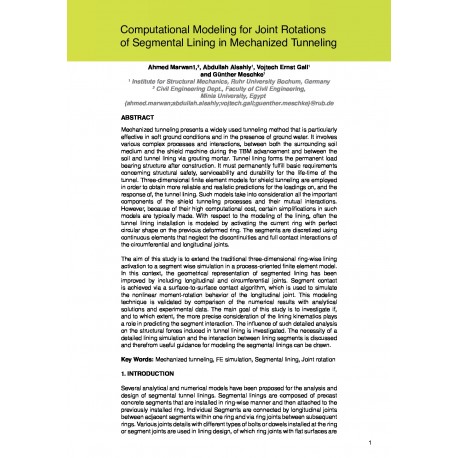Cart
0
0
No document
0,00 €
Total
Document successfully added to your shopping cart
Quantity
Total
There are 0 items in your cart.
There is 1 item in your cart.
Total documents
Total shipping
To be determined
Total
Search & filter
Search for a publication
Search & filter

Computational Modeling for Joint Rotations of Segmental Lining in Mechanized Tunneling
3496_computational_modeling_for_
A. Alsahly / G. Meschke / V. E. Gall / A. Marwan
Mechanized tunneling presents a widely used tunneling method that is particularly effective in soft ground conditions and in the presence of ground water. It involves various complex processes and interactions, between both the surrounding soil medium and the shield machine during the TBM advancement and between the soil and tunnel lining via grouting mortar. Tunnel lining forms the permanent load bearing structure after construction. It must permanently fulfill basic requirements concerning structural safety, serviceability and durability for the life-time of the tunnel. Three-dimensional finite element models for shield tunneling are employed in order to obtain more reliable and realistic predictions for the loadings on, and the response of, the tunnel lining. Such models take into consideration all the important components of the shield tunneling processes and their mutual interactions. However, because of their high computational cost, certain simplifications in such models are typically made. With respect to the modeling of the lining, often the tunnel lining installation is modeled by activating the current ring with perfect circular shape on the previous deformed ring. The segments are discretized using continuous elements that neglect the discontinuities and full contact interactions of the circumferential and longitudinal joints.The aim of this study is to extend the traditional three-dimensional ring-wise lining activation to a segment wise simulation in a process-oriented finite element model. In this context, the geometrical representation of segmented lining has been improved by including longitudinal and circumferential joints. Segment contact is achieved via a surface-to-surface contact algorithm, which is used to simulate the nonlinear moment-rotation behavior of the longitudinal joint. This modeling technique is validated by comparison of the numerical results with analytical solutions and experimental data. The main goal of this study is to investigate if, and to which extent, the more precise consideration of the lining kinematics plays a role in predicting the segment interaction. The influence of such detailed analysis on the structural forces induced in tunnel lining is investigated.


